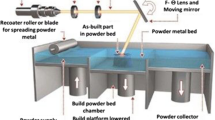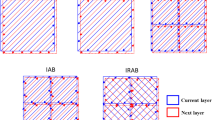Abstract
In the present study, fiber laser has been used in laser cladding with an off-axis powder injection. The aim of this study is to analyze the effects of the laser cladding process parameters on the clad layer geometry. The parameters studied were laser power, cladding speed, and powder feeding rate. This study was conducted by using single-pass clad layers. The powder material used was stainless steel AISI 316L and the substrate material used was structural steel S355. The relationship between the laser cladding process parameters and the clad layer geometry was established by using statistical analysis.
Analysis of the cladding results concluded that the laser power and cladding speed are the main parameters that control the clad layer width. The majority of the variations were in the clad height, but the clad bead side angle was also dependent on the powder feed rate and cladding speed. This study successfully established the relationship between the laser cladding process parameters and the clad geometry.










Similar content being viewed by others
References
Ion JC (2005) Laser processing of engineering materials: principles, procedure and industrial application. Butterworth-Heinemann, Oxford
Toyserkani E, Khajepour A, Corbin S (2005) Laser cladding. CRC, Florida
Tanaka Y, Nagai S, Ushida M, Usui T (2003) Large engine maintenance technique to support flight operation for commercial airlines. Mitsubishi Heavy Industries Technical Review 40(2):5
De Oliveira U, Ocelik V, De Hosson JTM (2005) Analysis of coaxial laser cladding processing conditions. Surf Coat Technol 197(2):127–136
Dubourg L, St-Georges L (2006) Optimization of laser cladding process using Taguchi and EM methods for MMC coating production. J Thermal Spray Technology 15(4):790–795
Lee HK (2008) Effects of the cladding parameters on the deposition efficiency in pulsed Nd: YAG laser cladding. J Mater Process Technol 202(1):321–327
Xu J, Li Z, Zhu W, Liu Z, Liu W (2007) Investigation on microstructural characterization of in situ TiB/Al metal matrix composite by laser cladding. Mater Sci Eng A 447(1):307–313
Chen H, Xu C, Chen J, Zhao H, Zhang L, Wang Z (2008) Microstructure and phase transformation of WC/Ni60B laser cladding coatings during dry sliding wear. Wear 264(7):487–493
Farayibi P, Folkes J, Clare A, Oyelola O (2011) Cladding of pre-blended Ti-6Al-4V and WC powder for wear resistant applications. Surf Coat Technol 206:372–377
Salehi, D. 2005, Sensing and control of Nd:YAG laser cladding process (Ph.D Thesis). Swinburne University of Technology, Australia.
De Damborenea J (1998) Surface modification of metals by high power lasers. Surf Coat Technol 100:377–382
Hoffmann, P. & Dierken, R. Laser system technology for surface treatment. Conference BTLA 2009.
Mahrle A, Schmidt J, Weiss D (2000) Simulation of temperature fields in arc and beam welding. Heat Mass Transf 36(2):117–126
Kar A, Mazumder J (1996) Modeling in laser materials processing: melting, alloying, cladding. NATO ASI Series E Applied Sciences-Advanced Study Institute 307:129–156
Kar A, Mazumder J (1988) One-dimensional finite-medium diffusion model for extended solid solution in laser cladding of Hf on nickel. Acta Metall 36(3):701–712
Rostami AA, Raisi A (1997) Temperature distribution and melt pool size in a semi-infinite body due to a moving laser heat source. Numer Heat Transfer Part A: Applications 31(7):783–796
Ziegler U (1999) A three-dimensional Cartesian adaptive mesh code for compressible magnetohydrodynamics. Comput Phys Commun 116(1):65–77
Sallamand P, Pelletier J (1993) Laser cladding on aluminium-base alloys: microstructural features. Mater Sci Eng A 171(1–2):263–270
Peng L, Taiping Y, Sheng L, Dongsheng L, Qianwu H, Weihao X, Xiaoyan Z (2005) Direct laser fabrication of nickel alloy samples. Int J Mach Tools Manuf 45(11):1288–1294
Chryssolouris G, Zannis S, Tsirbas K, Lalas C (2002) An experimental investigation of laser cladding. CIRP Ann Manuf Technol 51(1):145–148
Valsecchi B, Previtali B, Vedani M, Vimercati G (2010) Fiber laser cladding with high content of WC-co based powder. Int J Mater Form 3:1127–1130
Bi, G., Zhang, X. & Pashby, I. 2008, Study on the deposition of Ni-base waspaloy powder via high power fiber laser, Photonics Global@ Singapore, 2008. IPGC 2008. IEEE, pp. 1.
Nowotny S, Scharek S, Schmidt A (2007) Advanced laser technology applied to cladding and buildup. Weld J N Y 86(5):48
Author information
Authors and Affiliations
Corresponding author
Additional information
Recommended for publication by Commission I - Additive Manufacturing, Surfacing, and Thermal Cutting
Rights and permissions
About this article
Cite this article
Goodarzi, D.M., Pekkarinen, J. & Salminen, A. Analysis of laser cladding process parameter influence on the clad bead geometry. Weld World 61, 883–891 (2017). https://doi.org/10.1007/s40194-017-0495-0
Received:
Accepted:
Published:
Issue Date:
DOI: https://doi.org/10.1007/s40194-017-0495-0




